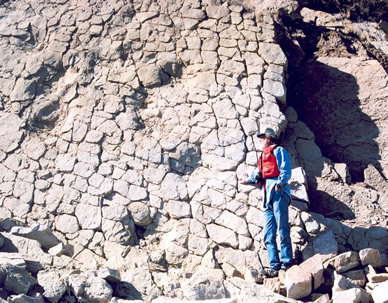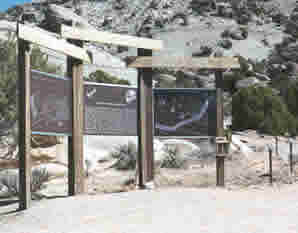- Reclamation
- Cultural and Paleontological Resources
- Fossil Resources
Bureau of Reclamation's Fossil Resources
Click on the following image or click here to view the Fossils on Federal and Indian Lands document.
Fossils are the remains, imprints, and traces of once-living organisms preserved in the earth's crust. They may be bones and teeth, shells, leaf impressions, footprints, or burrows. Fossils are non-renewable and (except for microfossils and those that make up the energy minerals) relatively rare resources with significant scientific, educational, commercial, and recreational values.
Paleontology is the science which uses fossils to study life in past geologic times. Early inits history, the Bureau of Reclamation recognized the importance of fossils. A 1905 circular produced by the agency included the following language, "In constructing irrigation works it is probable that fossiliferous beds will be uncovered, giving exceptionally good opportunities for collecting specimens of value to geologists and paleontologists. Well-preserved imprints of leaves, ferns, or other plant remains, fossil shells, and the bones and teeth of animals are always interesting, and may add much to our knowledge of the geologic history and structure of the region."
To date, Reclamation has documented close to 180 paleontological sites on its land, and maintains roughly 25,000 fossils as museum property. Some significant paleontological discoveries and research have occurred on Reclamation land.
At Harry Strunk Lake in southwest Nebraska, excavations of archaeological and paleontological remains were initiated in the 1940s when the dam forming the lake was constructed. Impressive remains of several Pleistocene species, such as saber-tooth tiger and shovel-tusked mammoth were recovered.
In the late 1980s, the remains of an 18,500 year old mammoth were discovered eroding out of the reservoir bank. The site contains bone flakes, impact points, and other patterns which would seem to indicate human presence at a very early period. Part of the mammoth was excavated, but more than half was left in place for future research. This was done because research techniques such as DNA identification, methods of determining the age of the deposits, and other forms of microscopic and chemical analysis, are rapidly improving and changing. Future excavations using advanced methods and technology might yield important information that would be lost if the excavations were done today.
At Flaming Gorge Reservoir in northeastern Utah, a number of agencies were involved in recording the footprints of ancient sauropods, long-necked dinosaurs who roamed the area about 180 million years ago. Also found were the much rarer tracks of a pterosaur, a flying reptile that lived between 220 and 65 million years ago. Ongoing research continues to reveal more information about the prehistoric animals. To protect the sites, their locations are not public information at this time.

Dinosaur tracks at Flaming Gorge Reservoir
The public has an opportunity to view fossilized plants and marine animals and even fragments of dinosaur bones in their natural setting at the Cottonwood Creek Dinosaur Trail, located about 25 miles southwest of Casper, Wyoming, at Reclamation’s Alcova Reservoir.
The rock formations along the trail include many invertebrate, vertebrate, and plant fossils, indicating a rapidly changing environment of deposition 200-140 million years ago with tidal flats, sand dunes, beaches, oceans, storm deposits, and complex stream and river systems.
In 1991, fossilized skeletal remains of a medium-sized dinosaur (Camarasaurus) were discovered at the site. In 1993, fossil remains of a small Ornithopod, nicknamed "Sniffles", were found. Most of the actual dinosaur bones which have been discovered to date have been removed for preparation and study and now reside at the University of Wyoming in Laramie.

Cottonwood Creek Dinosaur Trail
Alcova Reservoir
The best remaining examples of dinosaur bones can be seen near the top of Cottonwood Creek Dinosaur Trail, which is approximately 2 miles long and rises nearly 300 feet in elevation. The extreme, unstable slopes and switchbacks contribute to continually changing trail conditions. The trail user should be in good physical condition and exercise caution. Due to the rugged terrain, the trail is not accessible to the mobility impaired, although interpretive signs located at the trailhead are accessible. Estimated time to complete the self-guided tour along the trail is 2-3 hours. Collection of fossils by the public is prohibited along the trail.
Paleontological resources are protected under Federal property rules and regulations. Anyone wishing to collect fossils on Reclamation land must first obtain a permit. Permits are only issued for scientific research. They are given to people with specific qualifications that include related college education and experience. Prior to receiving a permit, applicants must also demonstrate that a Federal or Reclamation approved repository has agreed to accept any collected fossils. All collected items remain the property of the Federal Government and cannot be kept by the collector.
Information regarding fossil permits in Reclamation may be obtained from Joseph Giliberti, Acting Federal Preservation Officer, 303-445-3206.
Paleontological Resources Preservation Act
The Paleontological Resources Preservation Act (PRPA) Title VI, Subtitle D, of Public Law 111-011 requires the Secretaries of the Interior and Agriculture to manage and protect paleontological resources on Federal land using scientific principles and expertise. The law, which applies only to Federal lands managed by the U.S. Forest Service (USFS), Bureau of Reclamation (Reclamation), National Park Service (NPS), Fish and Wildlife Service (FWS) and the Bureau of Land Management (BLM), includes criminal and civil penalties for fossil theft and vandalism.
The law also provides authority for issuing permits for collecting paleontological resources. As directed by the Act, the agencies have published rules to implement the requirements of the law. The Department of Agriculture published a rule for land managed by the USFS in 2015. The Department of Interior (DOI) published a final rule for lands managed by Reclamation, BLM, FWS, and the NPS in 2022.
The DOI final rule provides for a coordinated and streamlined permit system for scientific investigations on land managed by Reclamation, BLM, FWS, and the NPS. For permit applications and inquiries on Reclamation managed land, please contact the regional archaeologist for the area you are interested in working. The final rule also provides for the possibility that some Reclamation managed land may be open for casual collection of certain common non-vertebrate fossils in the future. For questions about permits or other aspects of the rule as it pertains to other DOI agencies, or further information, please see the links provided below.
Other Federal Paleontology Websites
Links to some other Federal websites regarding paleontology follow:
National Park Service NPS Fossil Resources U.S.
Forest Service
Bureau of Land Management
BLM Paleontolotical Resources
NPS Fossils and Paleontology
Forest Service Paleontology
National Museum of Natural History
Smithsonian Paleobiology



